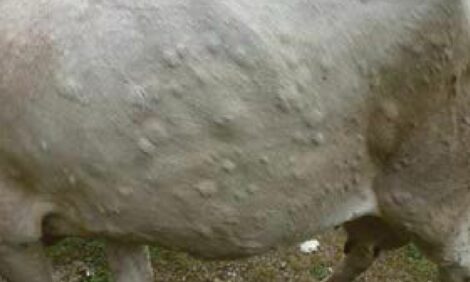



Out-Wintering of Cattle:Management and Precautions
Although money is saved on bedding and feed there are many potential negatives involved when wintering cattle outside warns the National Animal Disease Information Service who stress the importance of good management even in a mild winter.Out-wintering beef cattle has several potential advantages over housing but these have to be very carefully weighed against possible concerns over cow welfare during severe weather and under unsuitable field conditions. Out-wintering really only applies to adult beef cows calving in the spring. Young calves and store cattle should only be out-wintered if they are in areas of the UK which have reliably mild winter weather conditions.

Potential advantages of out-wintering include:
- Reduced feeding and bedding costs
- Reduced housing requirements -allows finishing of store cattle in housing. Reduced build-up of infection.
Potential disadvantages include:
- Difficulty of access to fields during adverse weather
- Poaching around restricted feed areas/ring feeders
- Excess loss of body condition if stock density too high in late autumn/early winter
- Increased risk of liver fluke from extended grazing period
For cattle to be out-wintered successfully on any system then their welfare and prevailing environmental conditions must be considered. The key need is shelter. This can be artificial such as an open fronted shed or a high solid wall or natural, such as a wood or copse. Forage supplied to out-wintering cows should be placed on a relatively high piece of ground, which drains well and which has a solid base. The feeding site must also be readily accessible to farm vehicles. Cattle standing knee deep in mud for their forage is not acceptable.
Reduced Feeding and Bedding Costs
Reduced feeding and bedding costs would typically apply in situations where spring-calving beef cows could be out-wintered on extensive grazing systems until December/January then housed for the last 2 to 3 months before calving. Typically stocking densities may range from one cow per 1.5-3 hectares depending upon conditions.

Reduced Housing Requirements - Allows Finishing of Store Cattle
Out-wintering cows would free up housing which could be used for intensive finishing of weaned/store cattle.

Reduced Housing - May Lead to Reduced Build-up of Infection
The important neonatal diseases, such as viral causes of diarrhoea, can be largely prevented by vaccination of the dam and good colostrum management. Build-up of infection can be reduced by mucking out the cattle accommodation before calving and due attention to the calving boxes/accommodation.
Access to Fields During Adverse Weather
The severe winter weather for several weeks/months in the winters of 2009/10 and 2010/11 presented many problems to farmers with cattle out-wintered away from the steading/big bale stores.

Poaching Around Restricted Feed Areas/Ring Feeders
Poaching around restricted feed areas/ring feeders can become a major problem with restricted grazing areas and no hard standings around ring feeders.



Excess Loss of Body Condition if Stock Density Too High in Late Autumn/Early Winter
Loss of body condition may not be readily noticed as beef cows grow their coat in late autumn/winter and it proves very difficult, if not impossible, to restore body condition during late gestation.
Increased Risk of Liver Fluke from Extended Grazing Period
There is an increased risk of liver fluke from the extended grazing period with infective stages still present on pasture until December in mild winters such as 2011/12. This may necessitate prophylactic treatment when the cattle are out-wintered which may prove time-consuming. A further treatment will likely prove necessary in January/February after housing.
Advanced Pregnancy
Advanced pregnancy/twins in out-wintered cows may present problems with gaining access to feed rings when cows are kept in fields unsuitable for that purpose.


Out-wintering can be a successful system - but it is not a low management system. Under UK conditions, even in mild winters, significant problems can occur. Out-wintering needs proper planning and preparation for most eventualities. Animal welfare needs to be the key priority and plans need to be in place to identify and provide solutions for problems arising in out-wintered cattle.

Further ReadingYou can view the full report by clicking here. |
January 2013
Copyright © NADIS 2007


